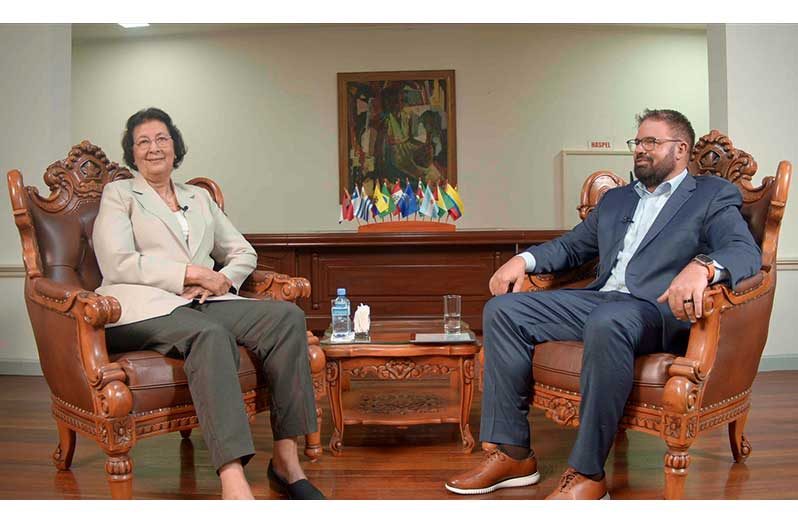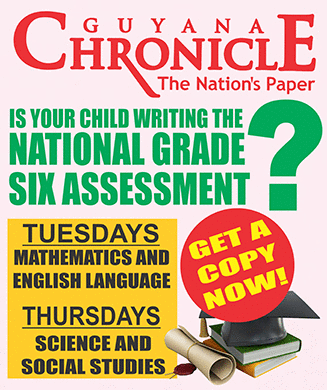-Highlights Guyana’s growing regional leadership
A RECENT Newsweek feature by six-time Emmy Award-winning television producer and columnist, Arick Wierson, has brought international attention to Suriname and the nation’s new president, Jennifer Geerlings-Simons, while also underscoring the extent to which Guyana’s development model under President Dr. Mohamed Irfaan Ali is now inspiring neighbouring countries across the region.
The article, titled “Suriname Is About to Be One of the Richest Countries on Earth. Is It Ready?”, was published in Newsweek on October 20. It presents Suriname as a nation standing on the brink of immense change as it prepares for an oil boom expected to begin in 2028.
Wierson describes the country’s transformation as “potentially one of the most dramatic in the Western Hemisphere,” projecting that output from French energy giant TotalEnergies could reach around 220,000 barrels per day, propelling economic growth of more than 50 percent.
Yet the piece also makes clear that Suriname is entering this new era under vastly different conditions than Guyana—and with much to learn from its neighbour’s experience.
“Surinamese people and Surinamese companies need to participate in everything that the oil will bring,” President Geerlings-Simons told Newsweek. “Otherwise, some people will get rich, and my people will stay poor—and that’s not what we want.”
GUYANA’S EXPERIENCE SETS THE BENCHMARK
Wierson draws numerous comparisons between the two countries, noting that Guyana’s oil-driven growth has become the global benchmark for managing new resource wealth in a developing economy.
Over the past five years, Guyana has recorded unprecedented growth averaging more than 40 per cent annually, becoming the world’s fastest-growing economy while making major investments in housing, health, education, infrastructure, and renewable energy.
The Newsweek feature on Suriname highlights that Guyana’s strong governance, institutional discipline, and forward-looking vision under President Ali have helped the country manage the challenges that come with sudden prosperity. The article implies that Suriname is now attempting to emulate that success.
Wierson observes that Suriname has been “watching the Guyanese experience unfold in real time—and taking notes.”
He writes that President Geerlings-Simons is consciously “borrowing a page from President Irfaan Ali’s playbook,” especially when it comes to using oil revenues as a vehicle for long-term sustainable development.
OIL AS A CATALYST FOR GREEN GROWTH
Much like President Ali’s Low Carbon Development Strategy 2030 (LCDS 2030), which channels petroleum income into forest protection and climate resilience, Geerlings-Simons told Newsweek that Suriname plans to direct oil revenues toward environmental preservation and green innovation.
“We think that the oil money will help us to protect our forests,” she said. “[Income from oil] will also give us the time to develop ways to earn money with our forests.”
Wierson notes that Suriname’s forests cover more than 93 percent of the country’s landmass—the highest proportion in the world—and that the nation could leverage this resource to generate additional income through carbon credits, biodiversity financing, and eco-tourism.
In many ways, this mirrors Guyana’s own globally recognised strategy, which has positioned the country as a leader in balancing economic growth with environmental stewardship. Under the LCDS 2030, Guyana became one of the first nations to monetise forest conservation through the sale of carbon credits—an initiative praised internationally as a model for climate-positive development.
Wierson’s piece, though focused on Suriname, indirectly affirms Guyana’s influence as a regional trailblazer—showing how its success is now shaping policymaking throughout the Amazon-Caribbean frontier.
NAVIGATING POLITICAL AND ECONOMIC CHALLENGES
At the same time, Newsweek notes that Suriname faces significant hurdles in replicating Guyana’s achievements. The country remains burdened by high debt levels and a fragile six-party coalition, both of which could complicate decision-making as oil wealth approaches.
President Geerlings-Simons—herself a former physician—used a medical metaphor to describe the state of her nation’s economy. “The patient is definitely not too well at the moment economically,” she told Wierson. “It needs some medicine.”
The Newsweek article interprets this as a call for institutional rebuilding, fiscal discipline, and patience before the oil revenues begin to flow. In contrast, Guyana’s steady fiscal management and strong public-investment framework have allowed it to convert petroleum earnings into tangible improvements in citizens’ lives—from major infrastructure projects to job creation and social programmes.
REGIONAL ENGAGEMENT AND SHARED LEADERSHIP
Adding to the narrative, the Newsweek piece is accompanied by an extensive video interview with President Geerlings-Simons, in which she elaborates on her government’s plans, the coalition she leads, and how she sees Suriname navigating its oil era. The visual format provides a deeper insight into her tone, priorities, and sense of urgency—offering an additional layer of transparency for international audiences.
Further strengthening the regional dimension, the two presidents held a formal bilateral meeting on September 13, 2025, in Nieuw Nickerie, Suriname, where President Ali and President Geerlings-Simons reviewed the state of bilateral relations and committed to deepen co-operation in energy, agriculture, border infrastructure, and connectivity. In their joint statement, both reaffirmed the historic bonds of friendship between their countries, and agreed to explore joint ventures, renewable-energy projects, and trade initiatives. This public encounter underscores how Guyana is actively engaging with Suriname not just as a neighbour, but as a partner in a shared development future.
GUYANA’S EXAMPLE RESONATES BEYOND ITS BORDERS
For Guyanese readers, Wierson’s article is further evidence that Guyana’s leadership in responsible resource management is setting the tone for the wider region. As international observers turn their attention to Suriname’s next chapter, Guyana’s achievements—guided by President Ali’s vision—are increasingly seen as the roadmap for how emerging oil economies can balance prosperity with sustainability.
In closing, Wierson writes that Suriname is a “patient in recovery—fragile, hopeful, and in need of discipline.” Whether it becomes “a miracle or a cautionary tale,” he suggests, will depend on how faithfully it follows its own prescription.
For many across the Caribbean and South America, that prescription already has a proven example—the Guyanese model, which continues to demonstrate that natural-resource wealth, when managed wisely, can be both a foundation for national transformation and a force for global environmental good.



.jpg)










